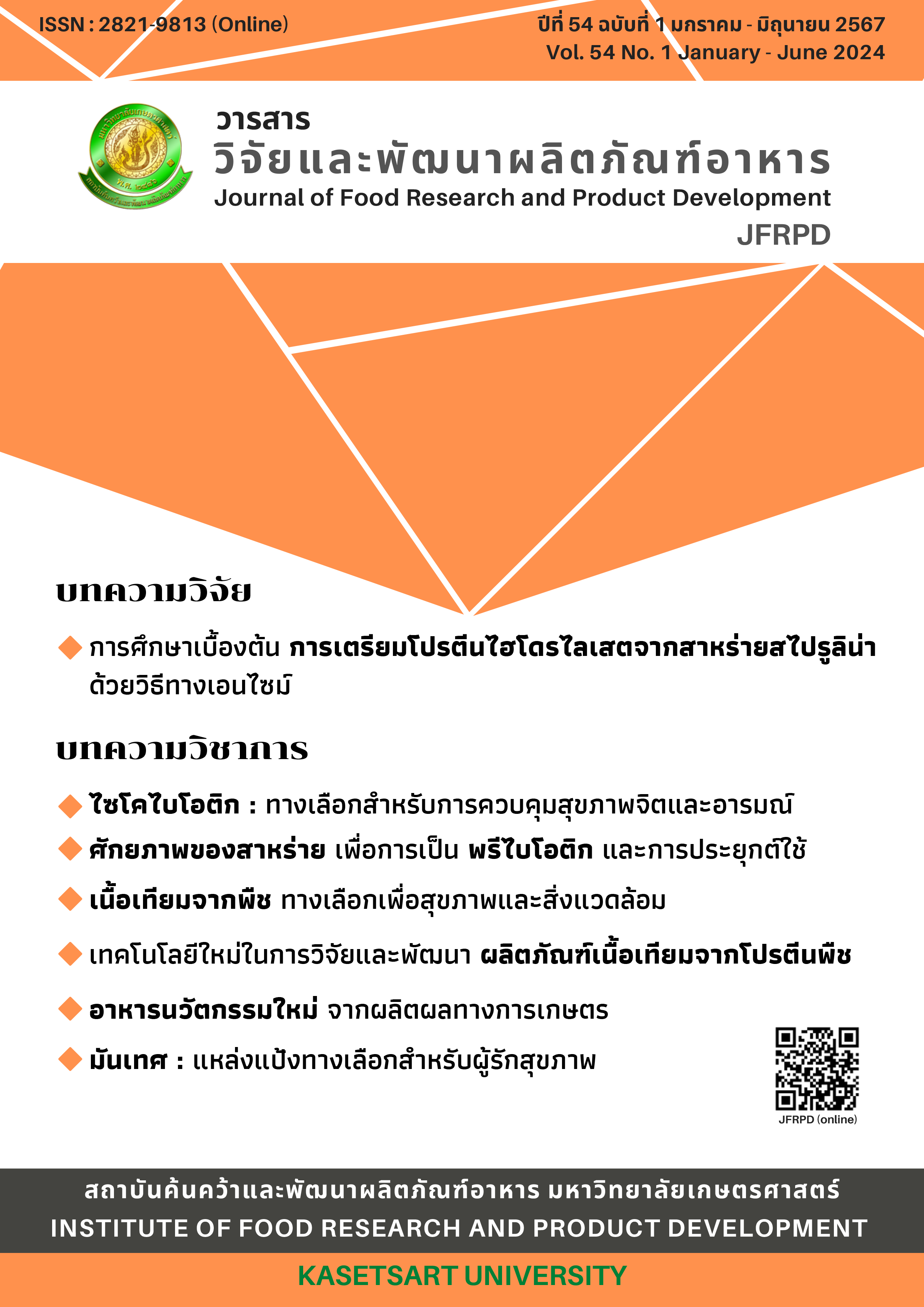เนื้อเทียมจากพืช ทางเลือกเพื่อสุขภาพและสิ่งแวดล้อม
##plugins.themes.bootstrap3.article.main##
บทคัดย่อ
ปัจจุบันมีความต้องการบริโภคเนื้อสัตว์เพิ่มมากขึ้นในทุกพื้นที่ทั่วโลกจากการเพิ่มขึ้นของจำนวนประชากร การเปลี่ยนแปลงของพฤติกรรมการบริโภคอาหาร ซึ่งการบริโภคเนื้อสัตว์ที่มากขึ้นทำให้อุตสาหกรรมเนื้อสัตว์จำเป็นต้องเพิ่มการผลิตให้ตอบสนองต่อตลาด ส่งผลกระทบต่อสิ่งแวดล้อม สวัสดิภาพของสัตว์ และสุขภาพของมนุษย์ ตั้งแต่การปล่อยก๊าซเรือนกระจก การตัดไม้ และภาวะขาดแคลนน้ำจากการปศุสัตว์ เพื่อจัดการกับปัญหานี้ แนวคิดเกี่ยวกับอาหารทดแทนเนื้อสัตว์จึงเกิดขึ้นเพื่อเพิ่มทางเลือกที่เหมาะสมและยังคงตอบสนองต่อความต้องการของผู้บริโภค โดยการจำลองเนื้อสัมผัสของเนื้อสัตว์คาดหวังว่า จะสามารถตอบสนองความต้องการบริโภคและแก้ปัญหาที่เกี่ยวข้องกับการปศุสัตว์ได้ เนื้อเทียมสามารถใช้วัตถุดิบได้หลากหลาย ทั้งสาหร่าย แมลงที่สามารถกินได้ และถั่วต่าง ๆ เพื่อให้ได้รับประสบการณ์ที่เหมือนกับการบริโภคเนื้อสัตว์จริง โปรตีนที่นำมาผลิตเนื้อเทียมจึงถูกผสมกับไขมันและส่วนผสมอื่น ๆ ผ่านกระบวนการผลิตเช่น กระบวนการเอ็กซ์ทรูชัน (extrusion) โดยกระบวนการเอ็กซ์ทรูชันแบบความชื้นสูง (high-moisture extrusion) ถือเป็นกระบวนการที่เป็นมิตรต่อสิ่งแวดล้อมมากที่สุดเมื่อเทียบกับการผลิตเนื้อเทียมด้วยวิธีการอื่น ๆ และกระบวนการผลิตเนื้อสัตว์
##plugins.generic.usageStats.downloads##
##plugins.themes.bootstrap3.article.details##

This work is licensed under a Creative Commons Attribution-NonCommercial-NoDerivatives 4.0 International License.
เอกสารอ้างอิง
Nations UNIES. World population prospects 2019: highlights. Department of Economic and Social Affairs, Population Division. Nosworthy, M. G., & House, J. D. (2017). Factors influencing the quality of dietary proteins: Implications for pulses. Cereal Chemistry. 2019;94(1):49-57.
Kyriakopoulou K, Dekkers B, van der Goot AJ. Plant-based meat analogues. Sustainable meat production and processing: Elsevier; 2019. p. 103-26.
ZionMarketReport. Global Plant Based Meat Market Will Reach USD 21.23Billion by 2025: Zion Market Research. 2019. p. https://www.globenewswire.com/news-release/2019/03/28/1781303/0/en/Global-Plant-Based-Meat-Market-Will-Reach-USD-21-23-Billion-By-2025-Zion-Market-Research.html
Meade SJ, Reid EA, Gerrard JA. The impact of processing on the nutritional quality of food proteins. J AOAC Int. 2005;88(3):904-22.
Xia Y, Qian J, Zhao Y, Zheng B, Wei K, Peng B, et al. Effects of food components and processing parameters on plant-based meat texture formation and evaluation methods. J Texture Stud. 2023;54(3):394-409.
Webb D, Li Y, Alavi S. Chemical and physicochemical features of common plant proteins and their extrudates for use in plant-based meat. Trends Food Sci Technol. 2022.
Baune M-C, Terjung N, Tülbek MÇ, Boukid F. Textured vegetable proteins (TVP): Future foods standing on their merits as meat alternatives. Future Foods. 2022:100181.
Nowacka M, Trusinska M, Chraniuk P, Drudi F, Lukasiewicz J, Nguyen NP, et al. Developments in plant proteins production for meat and fish analogues. Molecules. 2023;28(7):2966.
Imran M, Liyan Z. Production of plant-based meat: functionality, limitations and future prospects. European Food Res Technol. 2023:1-25.
Calkins CR, Hodgen JM. A fresh look at meat flavor. Meat Sci. 2007;77(1):63-80.
Sha L, Xiong YL. Plant protein-based alternatives of reconstructed meat: Science, technology, and challenges. Trends Food Sci Technol. 2020;102:51-61.
Yang D, Gao S, Yang H. Effects of sucrose addition on the rheology and structure of iota-carrageenan. Food Hydrocoll. 2020;99:105317.
Palanisamy M, Töpfl S, Aganovic K, Berger RG. Influence of iota carrageenan addition on the properties of soya protein meat analogues. LWT. 2018;87:546-52.
Wang Z, Tian B, Boom R, van der Goot AJ. Air bubbles in calcium caseinate fibrous material enhances anisotropy. Food Hydrocoll. 2019;87:497-505.
Dekkers BL, Boom RM, van der Goot AJ. Structuring processes for meat analogues. Trends Food Sci Technol. 2018;81:25-36.
Saerens W, Smetana S, Van Campenhout L, Lammers V, Heinz V. Life cycle assessment of burger patties produced with extruded meat substitutes. J Clean Prod. 2021;306:127177.
Hughes GJ, Ryan DJ, Mukherjea R, Schasteen CS. Protein digestibility-corrected amino acid scores (PDCAAS) for soy protein isolates and concentrate: Criteria for evaluation. J Agric Food Chem. 2011;59(23):12707-12.
Nosworthy MG, House JD. Factors influencing the quality of dietary proteins: Implications for pulses. Cereal Chem. 2017;94(1):49-57.
Kumar P, Chatli M, Mehta N, Singh P, Malav O, Verma AK. Meat analogues: Health promising sustainable meat substitutes. Critical reviews in food science and nutrition. 2017;57(5):923-32.
Tarté R. Ingredients in meat products: properties, functionality and applications: Springer; 2009.
Schuh V, Allard K, Herrmann K, Gibis M, Kohlus R, Weiss J. Impact of carboxymethyl cellulose (CMC) and microcrystalline cellulose (MCC) on functional characteristics of emulsified sausages. Meat Sci. 2013;93(2):240-7.
Bohrer BM. An investigation of the formulation and nutritional composition of modern meat analogue products. Food Sci Hum Wellness. 2019;8(4):320-9.
Graça J, Godinho CA, Truninger M. Reducing meat consumption and following plant-based diets: Current evidence and future directions to inform integrated transitions. Trends Food Sci Technol. 2019;91:380-90.

